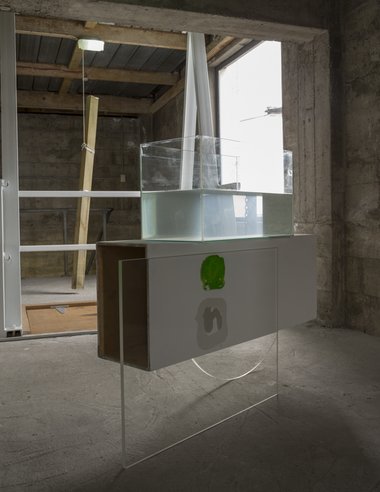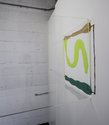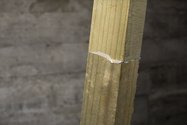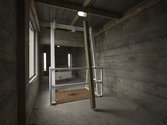John Hurrell – 4 November, 2013
This project has several layers. One is the dimension of faith on the viewer's part that the displayed substance is not glue mixed with colour. They take it on trust that the artist and curating gallery director are not lying. Another is the nature of the process these works are part of - for the gallery visitor. If the paint does not succeed as a glue, and the components of the sculptures fall apart, can the viewer visiting after that, mentally reconstruct the sequences of events?
Focussing on the adhesive properties of acrylic paint, this unusual exhibition by Mark O’Donnell examines a new functionality for the substance normally used for rendering form and coating flat planes. Creating a series of sculptures where paint is seen (often through Perspex) to be acting as a variety of glue, its optically attractive, spatial and malleable properties are played down and its ‘stickiness’ emphasised. These four demonstrations, celebrating the apparent laws of physics, are displayed in the high Artspace mezzanine and in the ‘front desk’ office below it - at the top of the stairs.
The fragile sculptures demonstrate leaning on a wall, precarious balancing over a floor, being horizontally attached to a vertical plane and being suspended from a ceiling. Exploiting gravity, they are modelled on the underpinning principles of a certain variety of late sixties art, notably the investigations into materiality (and ‘self-sustained’ stasis) by minimalists like Richard Serra, as well tangentially as earlier innovative painting experiments with decalcomania by Surrealists like Max Ernst and Oscar Dominguez.
This project has several layers. One is the dimension of faith on the viewer’s part that the displayed substance is not glue mixed with colour. They take it on trust that the artist and curating gallery director are not lying. Another is the nature of the process these works are part of - for the gallery visitor. If the paint does not succeed as a glue, and the components of the sculptures fall apart, can the viewer visiting after that, mentally reconstruct the sequences of events? It is something like a murder mystery perhaps where the ‘crime’ scene is searched for clues to be analysed and the end result the residue of some variety of timebased performance. Like that seen in the videos of Roman Signer.
Another aspect is the tension created by the possibility that the works might dramatically fall to bits and create havoc in the space. A tank full of water could spill over the upstairs floor, seep through the trapdoor and run through the downstairs office.
To accompany this show Caterina Riva has selected a piece of writing by Daphne Simons that discusses the controversial murder trial of esteemed minimalist sculptor Carl Andre, where he was acquitted of charges of murdering his wife, Mexican artist Ana Mendieta, by pushing her out of an apartment window. This topic could be a clever way of examining processes of deduction in detective work, based on looking at available evidence, especially if it happens that O’Donnell’s works do collapse. However the writer has made up her mind that Andre is culpable, and so the article seems malicious and gossipy, being subtly more about spleen than logic. A more impartial and considered account would have fitted in better with the processes at play in the installation, the physical traces before the visitor.
Another question arises about aesthetics. One could regard the wavy daubs and smears of coloured acrylic, when visible through Perspex, as too nonchalant, too indifferent. After all maybe the artist could have invented some imagery for the ‘glue’ that was interesting and relevant, that conceptually pertained in some way to the contextual situation at hand - although that may have ended up being too structurally convoluted, too ‘try-hard’? However this is an unusual and particularly engaging exhibition, so where O’Donnell goes from here with his brilliant ‘painting’ idea will undoubtedly attract considerable interest.
John Hurrell














 Advertising in this column
Advertising in this column Two Rooms presents a program of residencies and projects
Two Rooms presents a program of residencies and projects



This Discussion has 0 comments.
Comment
Participate
Register to Participate.
Sign in
Sign in to an existing account.